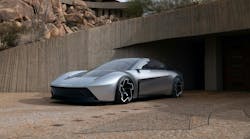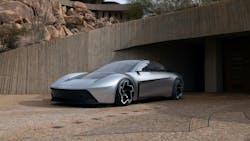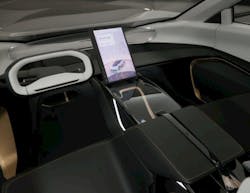Only a spoilsport would say so, and over the last month, several automakers have indicated that the transition from gasoline to electric vehicles (EVs) may not be the short-term savior that electronics hardware and software suppliers once hoped for. While the EV fraction of U.S. car sales continues to rise and overall EV demand (measured by sales) is still growing, electrification poses continuing challenges in optimal battery-management systems, standardized charging protocols, and system-wide EV integration.
Nevertheless, and despite bumps along the way, suppliers such as Stellantis is preparing to welcome its first battery electric vehicle (BEV), currently slated as a crossover model in 2025. And the Stellantis brand Chrysler will feature an all-electric portfolio in 2028.
Stellantis’s first BEV vehicle will be built on the STLA Large platform, which, according to the company, targets a 500-mile EV range. Fast charging will add up to 4.5 kWh per minute to an 800-V battery pack.
Undercarriage with Inductive Charging
The recently revealed Chrysler Halcyon Concept car on which the EV will be based also has an undercarriage designed to incorporate dynamic wireless power transfer (DWPT) inductive-charging technology to wirelessly recharge a vehicle as it travels.
Sensors integrated in the vehicle communicate with sensors under the road to provide much greater range without need of a charger, charge cord, or charge stations. Stellantis partnered in 2022 to demonstrate the potential of this technology at the Arena del Futuro circuit in Chiari, Italy.
The concept also envisions incorporating Lyten 800-V lithium-sulfur EV batteries that don’t use nickel, cobalt, or manganese, resulting in an estimated 60% lower carbon footprint than today's best-in-class batteries and a pathway to achieve the lowest-emissions EV battery on the global market. In May 2023, Stellantis Ventures, the corporate venture fund of Stellantis, announced an investment in Lyten to accelerate the commercialization of Lyten 3D Graphene applications.
STLA Leads to Level 4
The STLA AutoDrive technology platform will enable Level 4 autonomous-driving features that eliminate the stress of traffic using predictive navigation. The steering wheel and pedals retract, and the dimmable glass canopy and windshield can turn opaque for privacy and to create an immersive space. For instance, in Stargazing Mode, seats morph into a laid-back position while the augmented-reality windshield head-up display (HUD) projects information on stars and constellations.
Vehicles designed on STLA Large will be produced and sold globally, with eight vehicle launches across five brands planned from 2024 to 2026. The platform initially includes battery-pack options with energy ratings between 85 and 118 kWh.
Three-in-one electric drive modules (EDMs) that incorporate the motor, power inverter, and gear reduction can be configured in front-wheel-drive, rear-wheel-drive, and all-wheel-drive layouts. The power inverter employs silicon-carbide (SiC) semiconductor technology to minimize power losses. Propulsion system performance can be upgraded during the vehicle’s lifespan via over-the-air software updates.
STLA Large is one of four global platforms propelling Stellantis toward the ambitions of the company’s Dare Forward 2030 strategic plan. Full-size vehicles based on STLA Large will be used first in the North American market on Dodge and Jeep brands, followed by other brands including Alfa Romeo, Chrysler, and Maserati.
“Creating a family of vehicles from a well-engineered set of components that is flexible enough to cover multiple vehicle types and propulsions, over-performing any of our current products, will address each of our iconic brands’ customers,” said Stellantis CEO Carlos Tavares. “The flexibility and agility of this platform is its hallmark and will be a driving force for our success in the shift to electrification in North America.”
Halcyon’s Advanced Features
The Chrysler Halcyon Concept eliminates the traditional instrument panel, enabling occupants to take advantage of a footrest that runs the width of the car to better relax and enjoy the view from the windshield.
Thin, blade-like side mirrors house cameras for a slimmer aero profile, and autonomous entry into the concept eliminates the need for door handles. Both features enhance the concept's aerodynamic efficiency. Wheels are wrapped with low-rolling resistance 255/35R22 Pirelli tires.
An augmented-reality full-screen HUD shares important driving information, such as speed, charge status, and more. The augmented-reality HUD includes a Memory Landmark feature that pinpoints areas of interest and previously visited locations during the drive, with selectable and shareable landmark pins. The cockpit incorporates AI functionality—the Stellantis AI system allows the concept to diagnose issues and communicate OTA solutions without visiting a dealership.
Drivers can use voice recognition to deploy the steering wheel and control the vehicle through customized EV drive modes. Occupants can also watch movies and play games, and the adaptive environment has a media system that chooses audio and content based on the driver's personal preferences and history.
Prepare, Welcome/Entry, and Exit Modes
Customized EV drive modes enhance the driving experience with selectable levels of advanced driver-assistance system (ADAS) support. In Prepare Mode, a Stellantis AI virtual assistant preps for the day, notifying the driver and the Chrysler Halcyon Concept of upcoming events.
A personalized experience ties the vehicle with other connected devices, such as a smartphone or smart-home thermostat. And an Intelligent Cabin Comfort feature analyzes weather conditions and uses personalized preferences to remotely set HVAC levels. Predictive navigation syncs with the driver's calendar to prepare the vehicle for real-time traffic and navigation routing, eliminating unneeded driver inputs.
As the driver approaches the Chrysler Halcyon Concept, the vehicle recognizes the driver and provides a greeting through a Welcome Mode that uses biometric identification. In Welcome/Entry Modes, the driver is the "key" to unlocking the Concept, as facial biometrics allow for safe and secure, hands-free vehicle entry and startup, with doors unlocking and opening autonomously.
Illuminated LED exterior lighting animation, personalized exterior sound features, and a greeting on interior screens provide a sense of connection with the vehicle. Functional Chrysler wing logos on the side aero panels communicate vehicle charge status.
Rear seats retract into the trunk area to highlight a potential next-generation vision of the Chrysler Stow 'n Go seating, first invented for Chrysler minivans. The rear seats stow away either through biometric identification or voice command to open space for groceries, pet kennels and more.
The connected experience wraps up in Exit Mode, with automated parking features and automatic transformation of seats and ride height to accommodate vehicle egress. Smart exterior lighting enables vehicle-to-pedestrian communication, with indicator lighting such as blinkers or stopping displayed on the ground through near-field projection to aid in pedestrian safety. A send-off is communicated on the console screen and complemented through animated lighting and sounds.
Stellantis Electrification Roadmap
Stellantis is investing more than €50 billion over the next decade in electrification to deliver on its target of reaching a 100% passenger car BEV sales mix in Europe and 50% passenger car and light-duty truck BEV sales mix in the United States by 2030.
To achieve these sales targets, the company is securing approximately 400 GWh of battery capacity, including support from six battery manufacturing plants in North America and Europe. Stellantis plans to have 48 BEVs on the market by 2024 and said it’s on track to become a carbon net-zero corporation by 2038.


